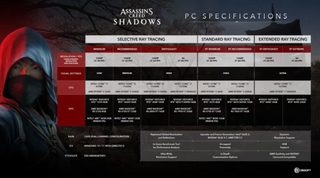- Ubisoft released PC requirements for Assassin’s Creed Shadows
- The extreme ray tracing preset needs an RTX 4090 for 60fps
- An RTX 3080 can run Shadows with ‘selective’ ray tracing at 1440p, achieving 60fps
Nvidia’s latest RTX 5090 GPU makes notable performance leaps over the previous generation’s flagship GPU, with additions such as Multi Frame Generation improving performance using ray tracing at 4K in games – and while the performance is impressive based on our RTX 5090 review, Ubisoft’s Assassin’s Creed Shadows hardware requirements suggest an RTX 4000 series GPU (or older) will suffice.
With the long-awaited title now available for pre-order and set for launch on March 20, Ubisoft has revealed the PC requirements (pictured below). As expected, the RTX 4090 is the highest recommended GPU for the extreme ray tracing preset at 4K to achieve 60 frames per second – this is while using DLSS 3.7, as DLSS 4 isn’t confirmed for the title yet.
If the RTX 4090 couldn’t run Shadows at those settings and maintain a good frame rate, there would be reasons to worry about the game – but as some of the other requirements reveal, an RTX 4070 Ti Super will reportedly be enough for standard ray-tracing and achieve 60fps at 4K, while an RTX 3080 will do the same at 1440p.
We’ll need to wait and see how the game performs on PC, as hardware requirements are rarely a good indication of optimization quality. Despite this, with the benefit of Frame Generation and the included XeSS and FSR 3.1 upscaling methods from Intel and AMD alongside Nvidia’s DLSS 3.7, it’s safe to say that an RTX 4000 series (and even an RTX 3000) GPU should be comfortably enough for gamers.

DLSS, FSR, and XeSS are the future of PC gaming, whether we like it or not
With features like frame-gen becoming more popular among many Nvidia, AMD, and Intel users, PC gaming will never be the same again. While ‘super-resolution’ (AI upscaling a lower rendered resolution to a higher output resolution) has been at the forefront of PC ports for a long while for providing better performance and image quality, it hasn’t faced as much criticism until now due to the addition of frame generation – which is being labeled as ‘fake frames’ by some users.
By using interpolated frames, the risk of increased input latency is present – fortunately, features like the new Reflex 2 from Nvidia are designed to reduce this. Yet other issues such as artifacting and ghosting (while improved) are still present in some games, which is evident in Daniel Owen‘s Multi Frame Generation testing in Cyberpunk 2077 as seen on YouTube.
I’ve already made my frustrations and worries about the future of optimization in PC games known – and while I have no doubts that Nvidia will work even harder at improving DLSS Frame Generation more as time goes by, not all GPU owners will have access to it (at least, for now). Hopefully, game developers don’t lose sight of ensuring games are capable of running in an acceptable fashion without relying solely on frame generation to do the job.
You may also like…
#Ubisoft #reveals #Assassins #Creed #Shadows #requirements #thought #youre #safe #RTX #series #GPU


